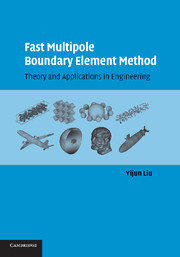Book contents
- Frontmatter
- Contents
- Preface
- Acknowledgments
- Acronyms Used in This Book
- 1 Introduction
- 2 Conventional Boundary Element Method for Potential Problems
- 3 Fast Multipole Boundary Element Method for Potential Problems
- 4 Elastostatic Problems
- 5 Stokes Flow Problems
- 6 Acoustic Wave Problems
- APPENDIX A Analytical Integration of the Kernels
- APPENDIX B Sample Computer Programs
- References
- Index
1 - Introduction
Published online by Cambridge University Press: 14 January 2010
- Frontmatter
- Contents
- Preface
- Acknowledgments
- Acronyms Used in This Book
- 1 Introduction
- 2 Conventional Boundary Element Method for Potential Problems
- 3 Fast Multipole Boundary Element Method for Potential Problems
- 4 Elastostatic Problems
- 5 Stokes Flow Problems
- 6 Acoustic Wave Problems
- APPENDIX A Analytical Integration of the Kernels
- APPENDIX B Sample Computer Programs
- References
- Index
Summary
What Is the Boundary Element Method?
The boundary element method (BEM) is a numerical method for solving boundary-value or initial-value problems formulated by use of boundary integral equations (BIEs). In some literature, it is also called the boundary integral equation method. Figure 1.1 shows the relation of the BEM to other numerical methods commonly applied in engineering, namely the finite difference method (FDM), finite element method (FEM), element-free (or meshfree) method (EFM), and boundary node method (BNM). The FDM, FEM, and EFM can be regarded as domain-based methods that use ordinary differential equation (ODE) or partial differential equation (PDE) formulations, whereas the BEM and BNM are regarded as boundary-based methods that use the BIE formulations. It should be noted that the ODE/PDE formulation and the BIE formulation for a given problem are equivalent mathematically and represent the local and global statements of the same problem, respectively. In the BEM, only the boundaries – that is, surfaces for three-dimensional (3D) problems or curves for two-dimensional (2D) problems – of a problem domain need to be discretized. However, the BEM does have similarities to the FEM in that it does use elements, nodes, and shape functions, but on the boundaries only. This reduction in dimensions brings about many advantages for the BEM that are discussed in the following sections and throughout this book.
Information
- Type
- Chapter
- Information
- Fast Multipole Boundary Element MethodTheory and Applications in Engineering, pp. 1 - 16Publisher: Cambridge University PressPrint publication year: 2009
